Mechanical Engineering Project: Building Energy Efficiency Analysis
VerifiedAdded on 2021/06/17
|6
|1693
|25
Project
AI Summary
This project investigates methods to reduce building heat and improve thermal relief, focusing on energy efficiency. It compares the energy consumption of buildings using DesignBuilder software, considering normal constraints, eco-roofing, PCM installation, and a combination of both. The methodology involves creating building designs, assigning weather conditions, and running simulations. Results show that eco-roofing reduces CO2 production and slightly decreases power consumption, while PCM installation lowers yearly power consumption. The most effective method is the combination of eco-roofing and PCM, which minimizes both CO2 and energy use. The project details the properties of materials like asphalt, glass wool, and plasterboard used in the simulations, providing a comprehensive analysis of building energy performance and the impact of different design choices.
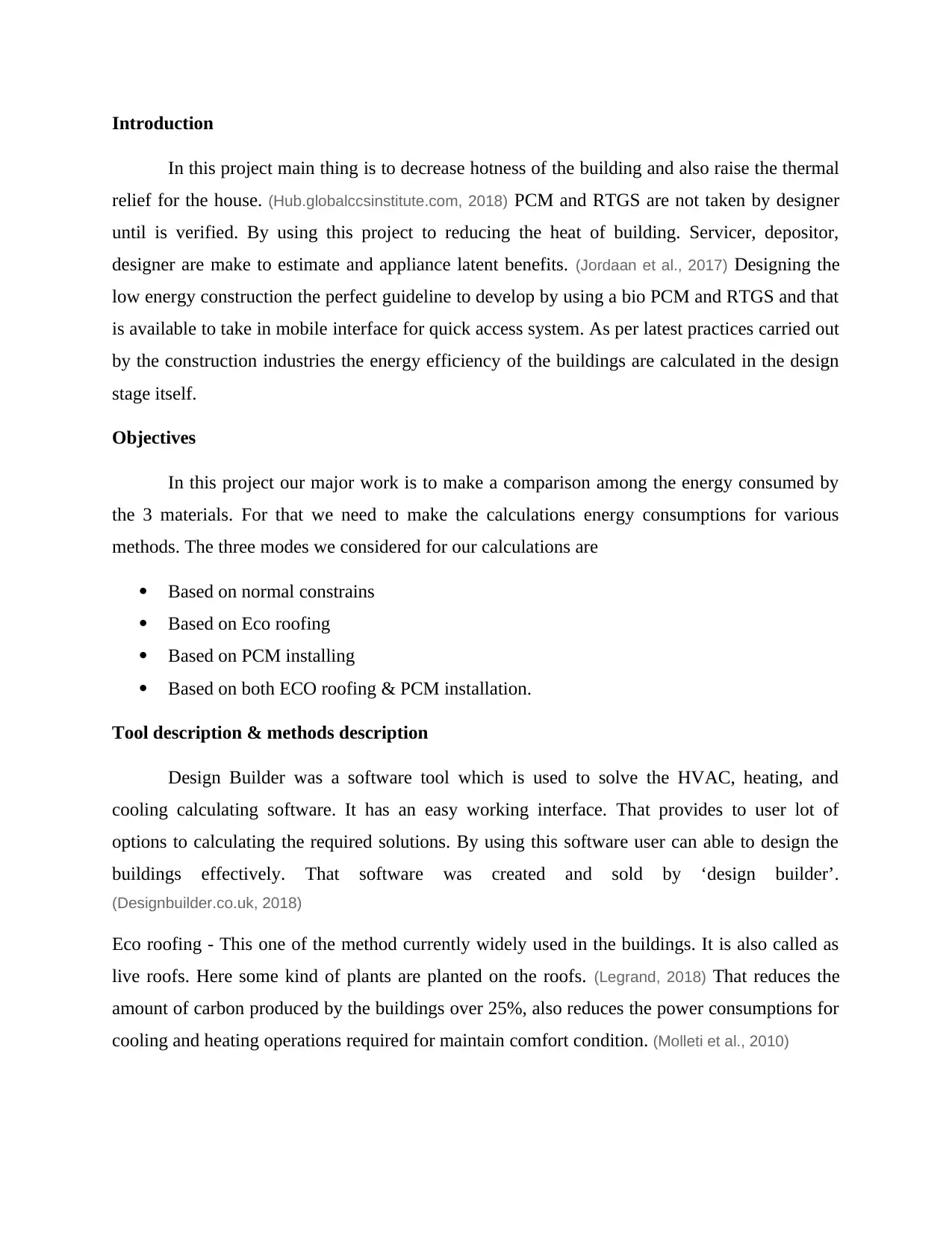
Introduction
In this project main thing is to decrease hotness of the building and also raise the thermal
relief for the house. (Hub.globalccsinstitute.com, 2018) PCM and RTGS are not taken by designer
until is verified. By using this project to reducing the heat of building. Servicer, depositor,
designer are make to estimate and appliance latent benefits. (Jordaan et al., 2017) Designing the
low energy construction the perfect guideline to develop by using a bio PCM and RTGS and that
is available to take in mobile interface for quick access system. As per latest practices carried out
by the construction industries the energy efficiency of the buildings are calculated in the design
stage itself.
Objectives
In this project our major work is to make a comparison among the energy consumed by
the 3 materials. For that we need to make the calculations energy consumptions for various
methods. The three modes we considered for our calculations are
Based on normal constrains
Based on Eco roofing
Based on PCM installing
Based on both ECO roofing & PCM installation.
Tool description & methods description
Design Builder was a software tool which is used to solve the HVAC, heating, and
cooling calculating software. It has an easy working interface. That provides to user lot of
options to calculating the required solutions. By using this software user can able to design the
buildings effectively. That software was created and sold by ‘design builder’.
(Designbuilder.co.uk, 2018)
Eco roofing - This one of the method currently widely used in the buildings. It is also called as
live roofs. Here some kind of plants are planted on the roofs. (Legrand, 2018) That reduces the
amount of carbon produced by the buildings over 25%, also reduces the power consumptions for
cooling and heating operations required for maintain comfort condition. (Molleti et al., 2010)
In this project main thing is to decrease hotness of the building and also raise the thermal
relief for the house. (Hub.globalccsinstitute.com, 2018) PCM and RTGS are not taken by designer
until is verified. By using this project to reducing the heat of building. Servicer, depositor,
designer are make to estimate and appliance latent benefits. (Jordaan et al., 2017) Designing the
low energy construction the perfect guideline to develop by using a bio PCM and RTGS and that
is available to take in mobile interface for quick access system. As per latest practices carried out
by the construction industries the energy efficiency of the buildings are calculated in the design
stage itself.
Objectives
In this project our major work is to make a comparison among the energy consumed by
the 3 materials. For that we need to make the calculations energy consumptions for various
methods. The three modes we considered for our calculations are
Based on normal constrains
Based on Eco roofing
Based on PCM installing
Based on both ECO roofing & PCM installation.
Tool description & methods description
Design Builder was a software tool which is used to solve the HVAC, heating, and
cooling calculating software. It has an easy working interface. That provides to user lot of
options to calculating the required solutions. By using this software user can able to design the
buildings effectively. That software was created and sold by ‘design builder’.
(Designbuilder.co.uk, 2018)
Eco roofing - This one of the method currently widely used in the buildings. It is also called as
live roofs. Here some kind of plants are planted on the roofs. (Legrand, 2018) That reduces the
amount of carbon produced by the buildings over 25%, also reduces the power consumptions for
cooling and heating operations required for maintain comfort condition. (Molleti et al., 2010)
Paraphrase This Document
Need a fresh take? Get an instant paraphrase of this document with our AI Paraphraser
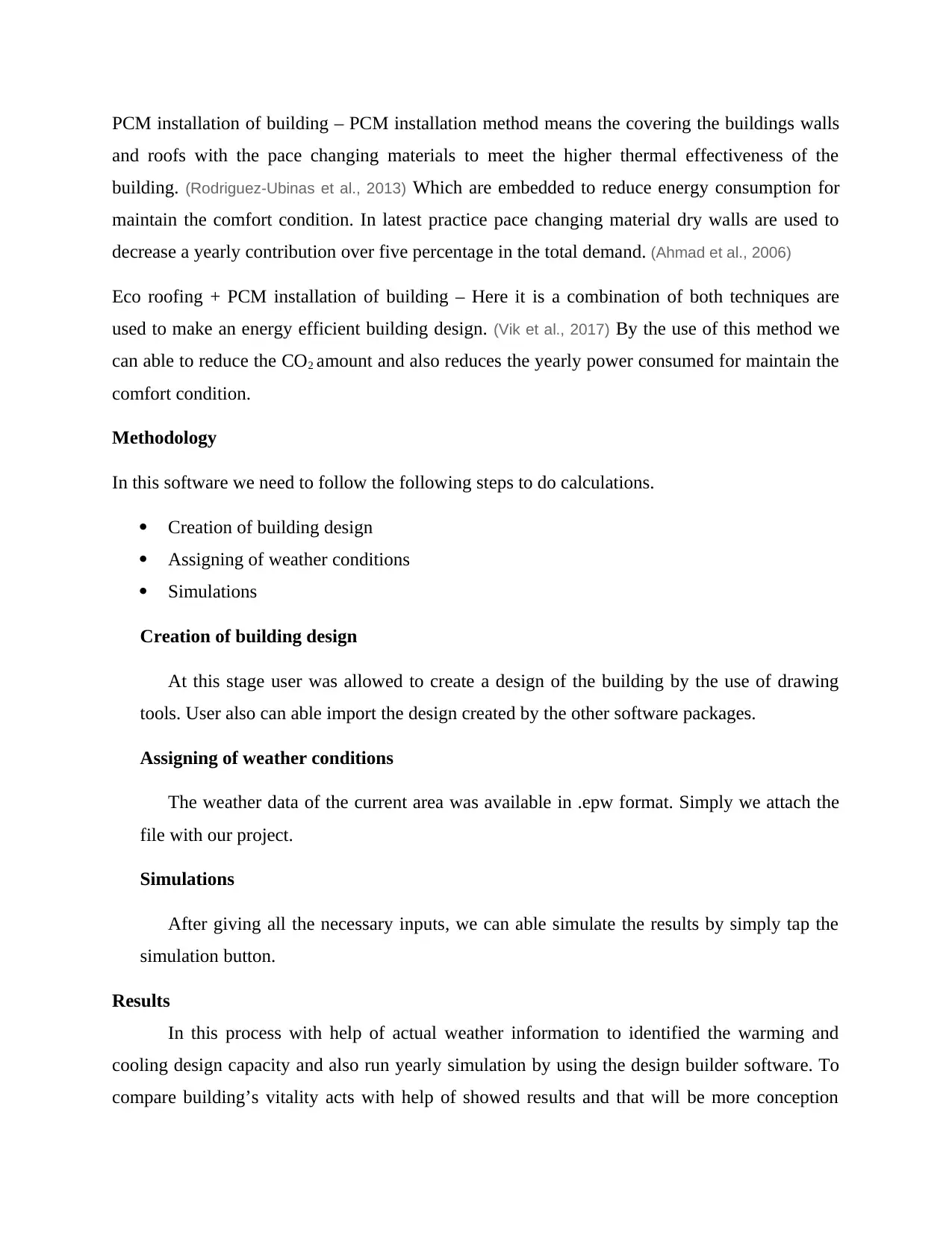
PCM installation of building – PCM installation method means the covering the buildings walls
and roofs with the pace changing materials to meet the higher thermal effectiveness of the
building. (Rodriguez-Ubinas et al., 2013) Which are embedded to reduce energy consumption for
maintain the comfort condition. In latest practice pace changing material dry walls are used to
decrease a yearly contribution over five percentage in the total demand. (Ahmad et al., 2006)
Eco roofing + PCM installation of building – Here it is a combination of both techniques are
used to make an energy efficient building design. (Vik et al., 2017) By the use of this method we
can able to reduce the CO2 amount and also reduces the yearly power consumed for maintain the
comfort condition.
Methodology
In this software we need to follow the following steps to do calculations.
Creation of building design
Assigning of weather conditions
Simulations
Creation of building design
At this stage user was allowed to create a design of the building by the use of drawing
tools. User also can able import the design created by the other software packages.
Assigning of weather conditions
The weather data of the current area was available in .epw format. Simply we attach the
file with our project.
Simulations
After giving all the necessary inputs, we can able simulate the results by simply tap the
simulation button.
Results
In this process with help of actual weather information to identified the warming and
cooling design capacity and also run yearly simulation by using the design builder software. To
compare building’s vitality acts with help of showed results and that will be more conception
and roofs with the pace changing materials to meet the higher thermal effectiveness of the
building. (Rodriguez-Ubinas et al., 2013) Which are embedded to reduce energy consumption for
maintain the comfort condition. In latest practice pace changing material dry walls are used to
decrease a yearly contribution over five percentage in the total demand. (Ahmad et al., 2006)
Eco roofing + PCM installation of building – Here it is a combination of both techniques are
used to make an energy efficient building design. (Vik et al., 2017) By the use of this method we
can able to reduce the CO2 amount and also reduces the yearly power consumed for maintain the
comfort condition.
Methodology
In this software we need to follow the following steps to do calculations.
Creation of building design
Assigning of weather conditions
Simulations
Creation of building design
At this stage user was allowed to create a design of the building by the use of drawing
tools. User also can able import the design created by the other software packages.
Assigning of weather conditions
The weather data of the current area was available in .epw format. Simply we attach the
file with our project.
Simulations
After giving all the necessary inputs, we can able simulate the results by simply tap the
simulation button.
Results
In this process with help of actual weather information to identified the warming and
cooling design capacity and also run yearly simulation by using the design builder software. To
compare building’s vitality acts with help of showed results and that will be more conception
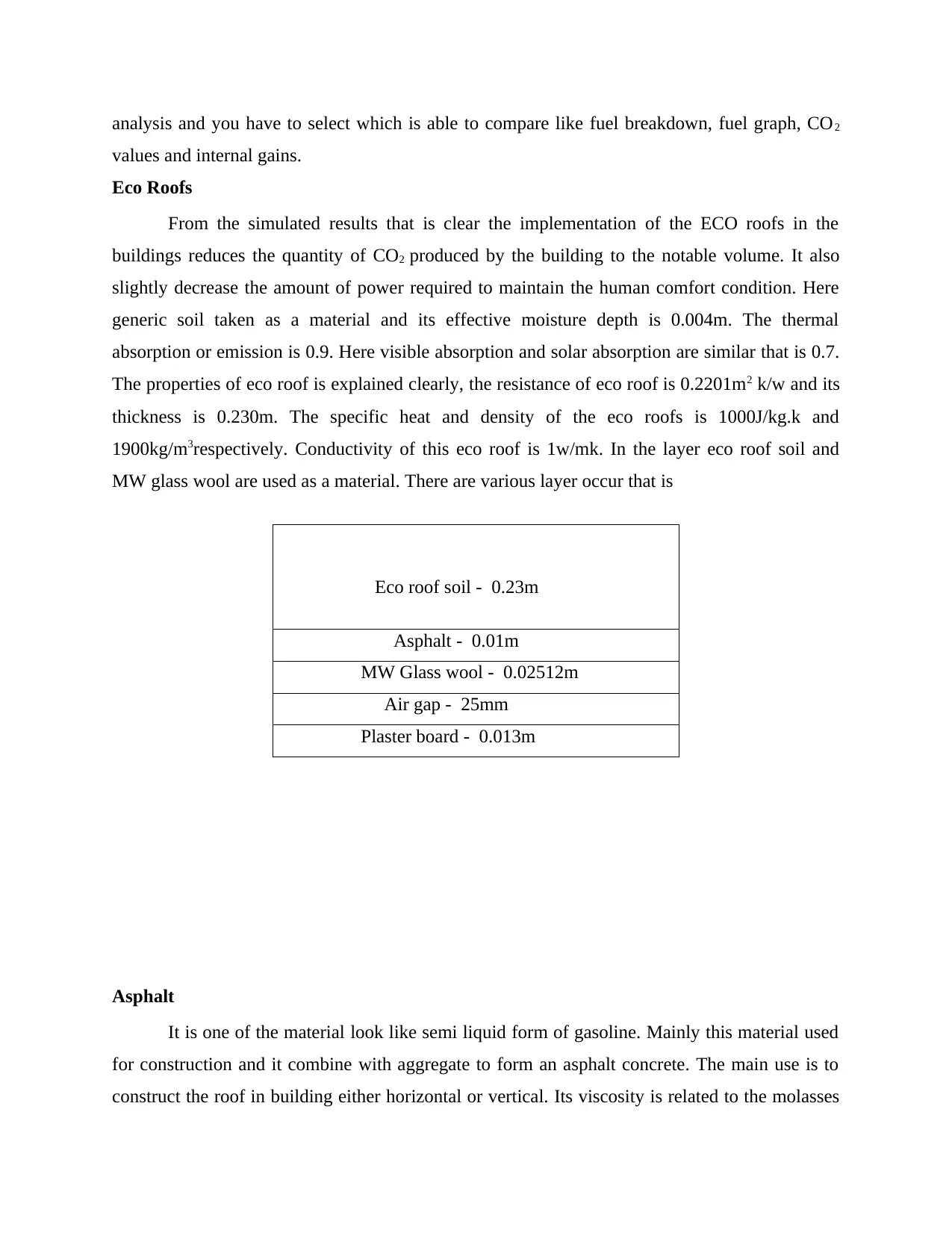
analysis and you have to select which is able to compare like fuel breakdown, fuel graph, CO2
values and internal gains.
Eco Roofs
From the simulated results that is clear the implementation of the ECO roofs in the
buildings reduces the quantity of CO2 produced by the building to the notable volume. It also
slightly decrease the amount of power required to maintain the human comfort condition. Here
generic soil taken as a material and its effective moisture depth is 0.004m. The thermal
absorption or emission is 0.9. Here visible absorption and solar absorption are similar that is 0.7.
The properties of eco roof is explained clearly, the resistance of eco roof is 0.2201m2 k/w and its
thickness is 0.230m. The specific heat and density of the eco roofs is 1000J/kg.k and
1900kg/m3respectively. Conductivity of this eco roof is 1w/mk. In the layer eco roof soil and
MW glass wool are used as a material. There are various layer occur that is
Asphalt
It is one of the material look like semi liquid form of gasoline. Mainly this material used
for construction and it combine with aggregate to form an asphalt concrete. The main use is to
construct the roof in building either horizontal or vertical. Its viscosity is related to the molasses
Eco roof soil - 0.23m
Asphalt - 0.01m
MW Glass wool - 0.02512m
Air gap - 25mm
Plaster board - 0.013m
values and internal gains.
Eco Roofs
From the simulated results that is clear the implementation of the ECO roofs in the
buildings reduces the quantity of CO2 produced by the building to the notable volume. It also
slightly decrease the amount of power required to maintain the human comfort condition. Here
generic soil taken as a material and its effective moisture depth is 0.004m. The thermal
absorption or emission is 0.9. Here visible absorption and solar absorption are similar that is 0.7.
The properties of eco roof is explained clearly, the resistance of eco roof is 0.2201m2 k/w and its
thickness is 0.230m. The specific heat and density of the eco roofs is 1000J/kg.k and
1900kg/m3respectively. Conductivity of this eco roof is 1w/mk. In the layer eco roof soil and
MW glass wool are used as a material. There are various layer occur that is
Asphalt
It is one of the material look like semi liquid form of gasoline. Mainly this material used
for construction and it combine with aggregate to form an asphalt concrete. The main use is to
construct the roof in building either horizontal or vertical. Its viscosity is related to the molasses
Eco roof soil - 0.23m
Asphalt - 0.01m
MW Glass wool - 0.02512m
Air gap - 25mm
Plaster board - 0.013m
⊘ This is a preview!⊘
Do you want full access?
Subscribe today to unlock all pages.

Trusted by 1+ million students worldwide
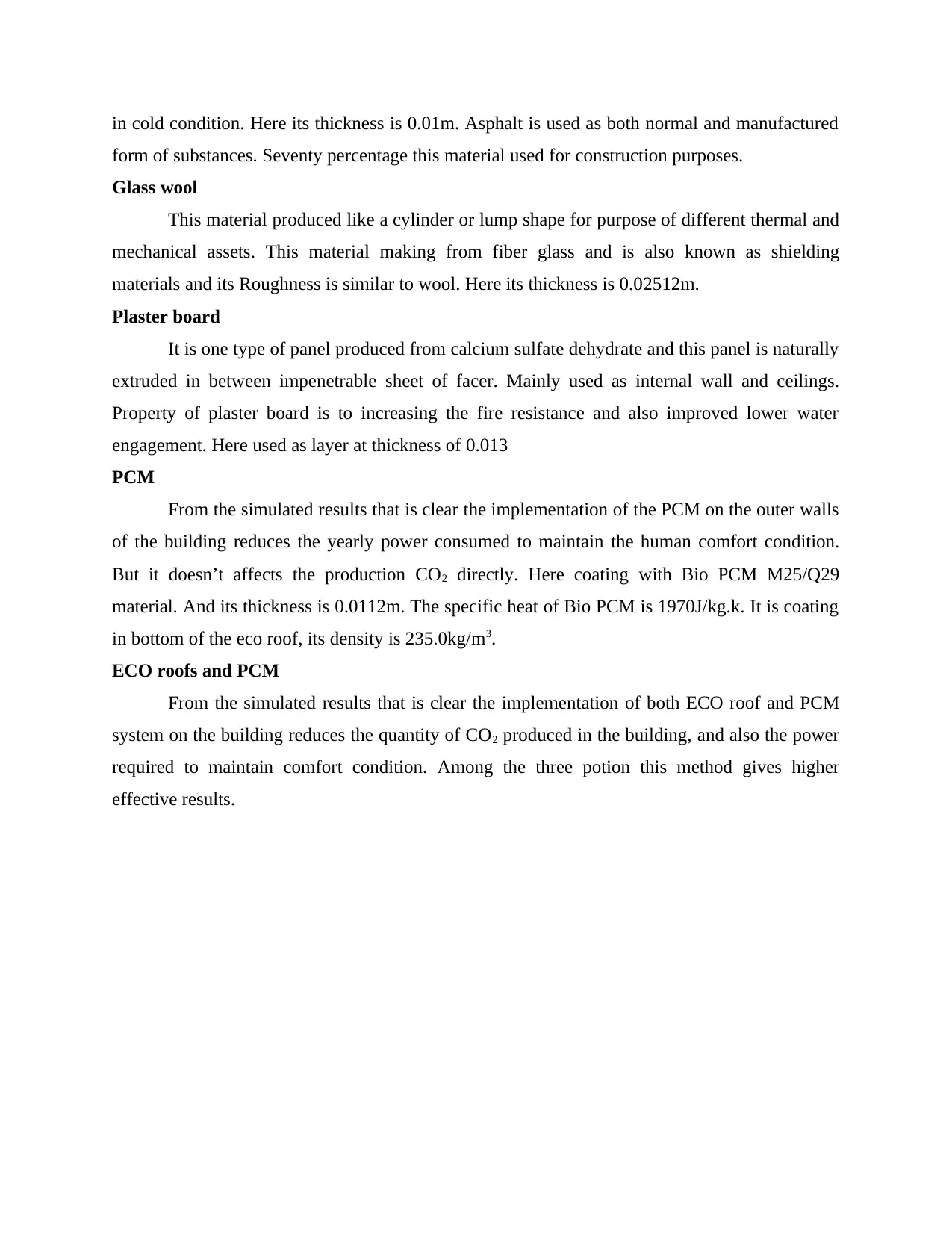
in cold condition. Here its thickness is 0.01m. Asphalt is used as both normal and manufactured
form of substances. Seventy percentage this material used for construction purposes.
Glass wool
This material produced like a cylinder or lump shape for purpose of different thermal and
mechanical assets. This material making from fiber glass and is also known as shielding
materials and its Roughness is similar to wool. Here its thickness is 0.02512m.
Plaster board
It is one type of panel produced from calcium sulfate dehydrate and this panel is naturally
extruded in between impenetrable sheet of facer. Mainly used as internal wall and ceilings.
Property of plaster board is to increasing the fire resistance and also improved lower water
engagement. Here used as layer at thickness of 0.013
PCM
From the simulated results that is clear the implementation of the PCM on the outer walls
of the building reduces the yearly power consumed to maintain the human comfort condition.
But it doesn’t affects the production CO2 directly. Here coating with Bio PCM M25/Q29
material. And its thickness is 0.0112m. The specific heat of Bio PCM is 1970J/kg.k. It is coating
in bottom of the eco roof, its density is 235.0kg/m3.
ECO roofs and PCM
From the simulated results that is clear the implementation of both ECO roof and PCM
system on the building reduces the quantity of CO2 produced in the building, and also the power
required to maintain comfort condition. Among the three potion this method gives higher
effective results.
form of substances. Seventy percentage this material used for construction purposes.
Glass wool
This material produced like a cylinder or lump shape for purpose of different thermal and
mechanical assets. This material making from fiber glass and is also known as shielding
materials and its Roughness is similar to wool. Here its thickness is 0.02512m.
Plaster board
It is one type of panel produced from calcium sulfate dehydrate and this panel is naturally
extruded in between impenetrable sheet of facer. Mainly used as internal wall and ceilings.
Property of plaster board is to increasing the fire resistance and also improved lower water
engagement. Here used as layer at thickness of 0.013
PCM
From the simulated results that is clear the implementation of the PCM on the outer walls
of the building reduces the yearly power consumed to maintain the human comfort condition.
But it doesn’t affects the production CO2 directly. Here coating with Bio PCM M25/Q29
material. And its thickness is 0.0112m. The specific heat of Bio PCM is 1970J/kg.k. It is coating
in bottom of the eco roof, its density is 235.0kg/m3.
ECO roofs and PCM
From the simulated results that is clear the implementation of both ECO roof and PCM
system on the building reduces the quantity of CO2 produced in the building, and also the power
required to maintain comfort condition. Among the three potion this method gives higher
effective results.
Paraphrase This Document
Need a fresh take? Get an instant paraphrase of this document with our AI Paraphraser
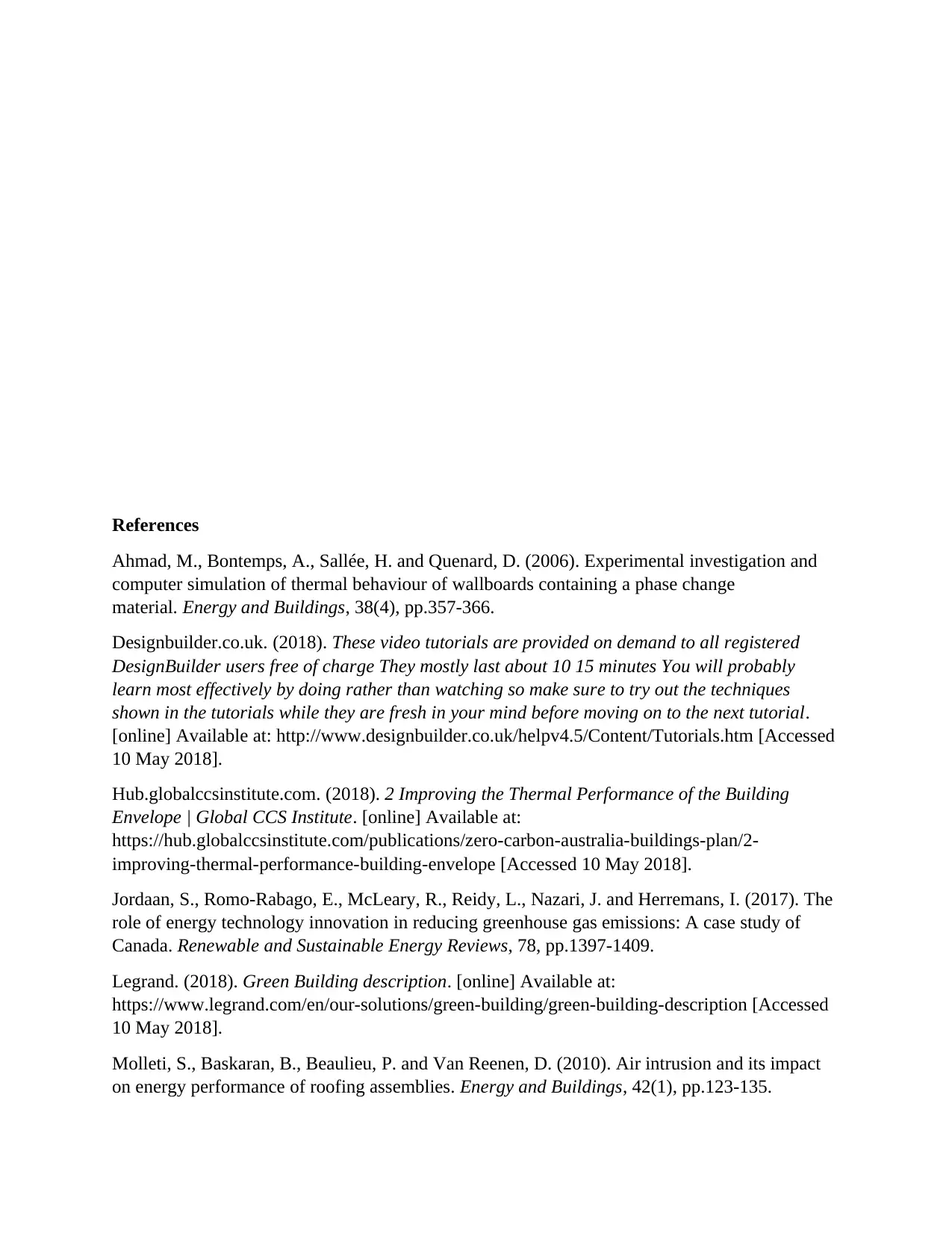
References
Ahmad, M., Bontemps, A., Sallée, H. and Quenard, D. (2006). Experimental investigation and
computer simulation of thermal behaviour of wallboards containing a phase change
material. Energy and Buildings, 38(4), pp.357-366.
Designbuilder.co.uk. (2018). These video tutorials are provided on demand to all registered
DesignBuilder users free of charge They mostly last about 10 15 minutes You will probably
learn most effectively by doing rather than watching so make sure to try out the techniques
shown in the tutorials while they are fresh in your mind before moving on to the next tutorial.
[online] Available at: http://www.designbuilder.co.uk/helpv4.5/Content/Tutorials.htm [Accessed
10 May 2018].
Hub.globalccsinstitute.com. (2018). 2 Improving the Thermal Performance of the Building
Envelope | Global CCS Institute. [online] Available at:
https://hub.globalccsinstitute.com/publications/zero-carbon-australia-buildings-plan/2-
improving-thermal-performance-building-envelope [Accessed 10 May 2018].
Jordaan, S., Romo-Rabago, E., McLeary, R., Reidy, L., Nazari, J. and Herremans, I. (2017). The
role of energy technology innovation in reducing greenhouse gas emissions: A case study of
Canada. Renewable and Sustainable Energy Reviews, 78, pp.1397-1409.
Legrand. (2018). Green Building description. [online] Available at:
https://www.legrand.com/en/our-solutions/green-building/green-building-description [Accessed
10 May 2018].
Molleti, S., Baskaran, B., Beaulieu, P. and Van Reenen, D. (2010). Air intrusion and its impact
on energy performance of roofing assemblies. Energy and Buildings, 42(1), pp.123-135.
Ahmad, M., Bontemps, A., Sallée, H. and Quenard, D. (2006). Experimental investigation and
computer simulation of thermal behaviour of wallboards containing a phase change
material. Energy and Buildings, 38(4), pp.357-366.
Designbuilder.co.uk. (2018). These video tutorials are provided on demand to all registered
DesignBuilder users free of charge They mostly last about 10 15 minutes You will probably
learn most effectively by doing rather than watching so make sure to try out the techniques
shown in the tutorials while they are fresh in your mind before moving on to the next tutorial.
[online] Available at: http://www.designbuilder.co.uk/helpv4.5/Content/Tutorials.htm [Accessed
10 May 2018].
Hub.globalccsinstitute.com. (2018). 2 Improving the Thermal Performance of the Building
Envelope | Global CCS Institute. [online] Available at:
https://hub.globalccsinstitute.com/publications/zero-carbon-australia-buildings-plan/2-
improving-thermal-performance-building-envelope [Accessed 10 May 2018].
Jordaan, S., Romo-Rabago, E., McLeary, R., Reidy, L., Nazari, J. and Herremans, I. (2017). The
role of energy technology innovation in reducing greenhouse gas emissions: A case study of
Canada. Renewable and Sustainable Energy Reviews, 78, pp.1397-1409.
Legrand. (2018). Green Building description. [online] Available at:
https://www.legrand.com/en/our-solutions/green-building/green-building-description [Accessed
10 May 2018].
Molleti, S., Baskaran, B., Beaulieu, P. and Van Reenen, D. (2010). Air intrusion and its impact
on energy performance of roofing assemblies. Energy and Buildings, 42(1), pp.123-135.
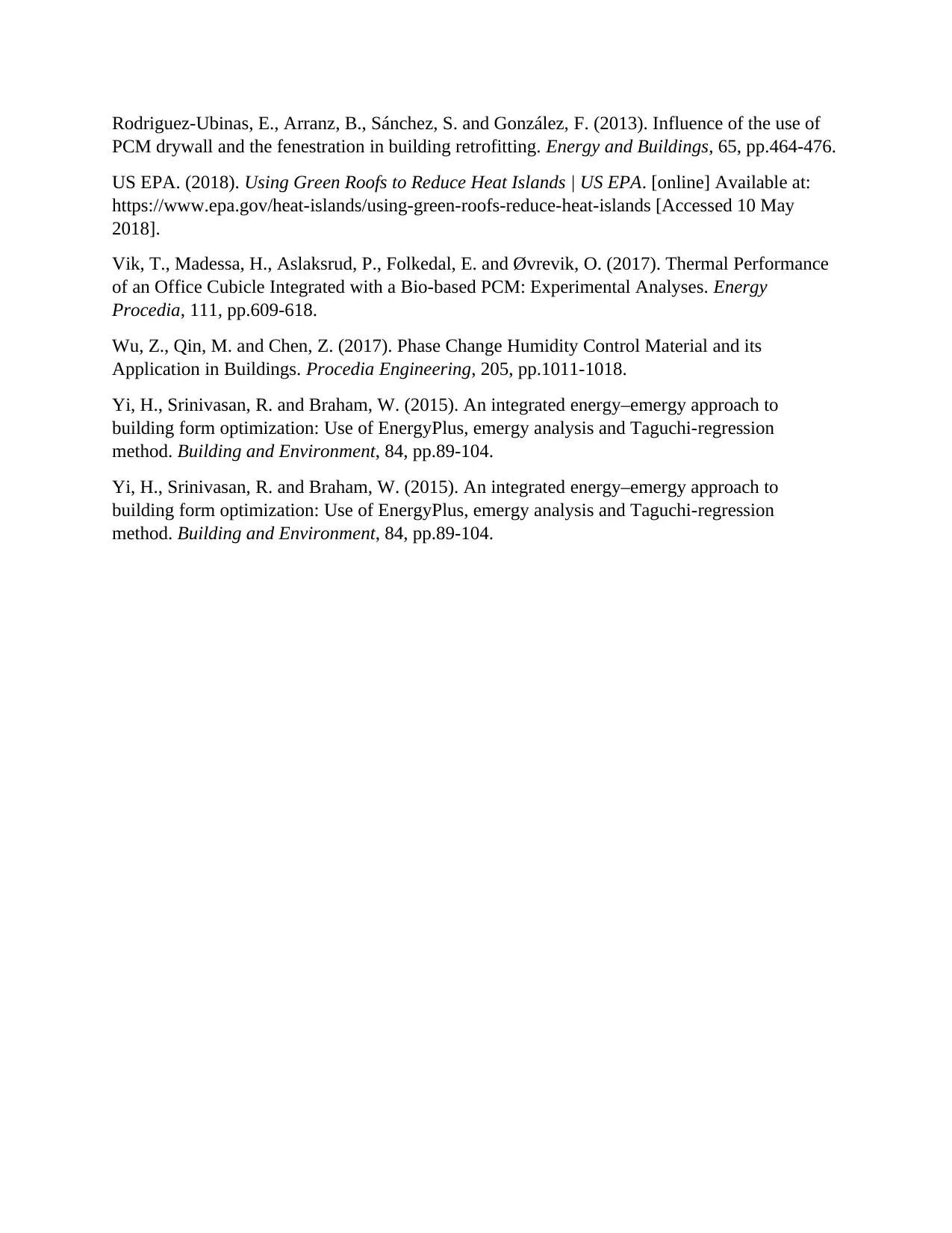
Rodriguez-Ubinas, E., Arranz, B., Sánchez, S. and González, F. (2013). Influence of the use of
PCM drywall and the fenestration in building retrofitting. Energy and Buildings, 65, pp.464-476.
US EPA. (2018). Using Green Roofs to Reduce Heat Islands | US EPA. [online] Available at:
https://www.epa.gov/heat-islands/using-green-roofs-reduce-heat-islands [Accessed 10 May
2018].
Vik, T., Madessa, H., Aslaksrud, P., Folkedal, E. and Øvrevik, O. (2017). Thermal Performance
of an Office Cubicle Integrated with a Bio-based PCM: Experimental Analyses. Energy
Procedia, 111, pp.609-618.
Wu, Z., Qin, M. and Chen, Z. (2017). Phase Change Humidity Control Material and its
Application in Buildings. Procedia Engineering, 205, pp.1011-1018.
Yi, H., Srinivasan, R. and Braham, W. (2015). An integrated energy–emergy approach to
building form optimization: Use of EnergyPlus, emergy analysis and Taguchi-regression
method. Building and Environment, 84, pp.89-104.
Yi, H., Srinivasan, R. and Braham, W. (2015). An integrated energy–emergy approach to
building form optimization: Use of EnergyPlus, emergy analysis and Taguchi-regression
method. Building and Environment, 84, pp.89-104.
PCM drywall and the fenestration in building retrofitting. Energy and Buildings, 65, pp.464-476.
US EPA. (2018). Using Green Roofs to Reduce Heat Islands | US EPA. [online] Available at:
https://www.epa.gov/heat-islands/using-green-roofs-reduce-heat-islands [Accessed 10 May
2018].
Vik, T., Madessa, H., Aslaksrud, P., Folkedal, E. and Øvrevik, O. (2017). Thermal Performance
of an Office Cubicle Integrated with a Bio-based PCM: Experimental Analyses. Energy
Procedia, 111, pp.609-618.
Wu, Z., Qin, M. and Chen, Z. (2017). Phase Change Humidity Control Material and its
Application in Buildings. Procedia Engineering, 205, pp.1011-1018.
Yi, H., Srinivasan, R. and Braham, W. (2015). An integrated energy–emergy approach to
building form optimization: Use of EnergyPlus, emergy analysis and Taguchi-regression
method. Building and Environment, 84, pp.89-104.
Yi, H., Srinivasan, R. and Braham, W. (2015). An integrated energy–emergy approach to
building form optimization: Use of EnergyPlus, emergy analysis and Taguchi-regression
method. Building and Environment, 84, pp.89-104.
⊘ This is a preview!⊘
Do you want full access?
Subscribe today to unlock all pages.

Trusted by 1+ million students worldwide
1 out of 6
Related Documents
Your All-in-One AI-Powered Toolkit for Academic Success.
+13062052269
info@desklib.com
Available 24*7 on WhatsApp / Email
![[object Object]](/_next/static/media/star-bottom.7253800d.svg)
Unlock your academic potential
Copyright © 2020–2025 A2Z Services. All Rights Reserved. Developed and managed by ZUCOL.





